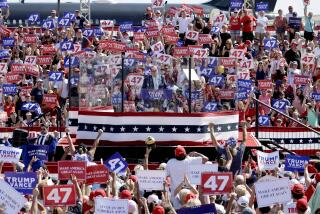Biden campaign had three times more money than Trump’s as they entered the final phase

- Share via
President Trump entered the final weeks of the campaign at a severe financial disadvantage to Democratic nominee Joe Biden, according to fundraising disclosures filed Tuesday night with the Federal Election Commission.
Biden’s campaign ended September with $180.6 million in the bank, while Trump’s committee reported $63.1 million.
The Trump campaign insisted that it had enough money to fully fund its operations through election day and noted that Trump won in 2016 despite having fewer resources than Democratic nominee Hillary Clinton.
“The Trump campaign has all the resources we need going into the homestretch of this election,” spokeswoman Samantha Zager said. “As Hillary Clinton proved when she outspent us 2 to 1 in 2016, no amount of money can buy the presidency — voters have to be enthusiastic about casting their ballot for a candidate, and that’s only happening for President Trump.”
Still, the financial gap helps explain why the president on Sunday — 16 days before election day — took hours off the campaign trail to headline a high-dollar fundraiser in Newport Beach.

Both men have outside groups and party committees supporting their efforts. But the new numbers show how dramatically the finances for each campaign have changed in the 2020 election.
Trump began raising money as soon as he took office in 2017 and built a juggernaut operation that his campaign once referred to as “the Death Star.” But the campaign spent lavishly on travel and other unnecessary expenses. It aired an ad during the Super Bowl, months before the president even knew which Democrat he would be running against, and it broadcast TV ads in Washington, D.C., an overwhelmingly Democratic city where Trump got only 4% support in 2016 — but whose residents include a president who is an avid consumer of television.
Biden was viewed as a lackluster fundraiser during the Democratic primary and did not show real strength until he clinched the nomination. Then, the money started to flow, until COVID-19 shut down in-person fundraisers.
Biden’s campaign aggressively raised money through creative virtual fundraisers, participating in events with the Democratic Party’s most popular politicians and a wide variety of supporters. Fashionistas could donate to hear Vogue editor Anna Wintour speak; foodies could see chef José Andrés; television junkies could hear from the casts of “The West Wing” or “Will & Grace.” Democratic donors were also galvanized by a number of events in recent months, none more so than the September death of Supreme Court Justice Ruth Bader Ginsburg.
All that led to Biden raising $383 million in the third quarter — $125 million more than Trump.
Biden’s financial advantage is easily visible on the airwaves, as he has expanded to airing ads in states once considered out of his reach and during NFL games. A 60-second ad calling for a “fresh start,” narrated by actor Sam Elliott, ran during Tuesday’s World Series opener.
“There is so much we can do if we choose to take on problems and not each other and choose a president who brings out our best,” Elliott said. “Joe Biden doesn’t need everyone in this country to always agree, just to agree that we all love this country and go from there.”
A look at where President Trump and Joe Biden stand on key issues in the 2020 election, including healthcare, immigration, police reform and climate.
More to Read
Get the L.A. Times Politics newsletter
Deeply reported insights into legislation, politics and policy from Sacramento, Washington and beyond. In your inbox twice per week.
You may occasionally receive promotional content from the Los Angeles Times.












